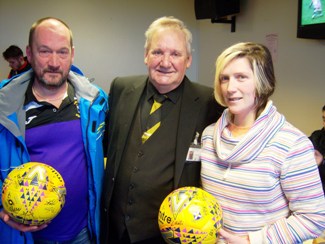Home
Gordon Davidson with signed match balls
Gordon Davidson and his daughter were presented with their signed footballs by our Commercial Director, Ken Henderson, after the match on Saturday, 10th March against Airdrie. Gordon is a sponsor of our main draw and as a result, was entitled to matchball and hospitality. He also had further matchball hospitality on the day for his 54th Birthday, thus marking a successful day all round and of course, another signed football.
East Fife Fan from London's East End Celebrates 70th Birthday.

The father of Richard Bronzite, Louis, pictured above celebrated his 70th Birthday recently. Louis lives in the East End of London and has never seen East Fife play but has been a fan of the Club since his schooldays. In those days, it was common for English school boys to choose a Scottish team to support as well as the local English Team. He has followed The Fife from those days and looked out for the results. Of course, Saturday's result against Airdrie made his day! Above , you can see him with his letter of thanks from the Directors of the Club and he is now proudly sporting his East Fife Supporter's Club Badge. The next thing of course is for his family to send him to the Costa del Fife to see for himself, The Mighty Fife.
New Addition To East Fife Family
Congratulations to Jonathan Page and his wife Gillian on the birth of their daughter Florence Rose. Everyone at East Fife is delighted for them!
Bayview Restaurant Open Today For Lunches
Today, Tuesday, 6th March 2018, the Bayview Restaurant opens for light lunches from 12 noon till 2.30pm. Open on Tuesdays, Wednesdays, Thursdays , Fridays and Sundays.Closed on Mondays.No need to book, just drop in!
High Teas served only on Sundays from 2pm till 6pm - (see separate advertisement)
The menu is as follows -
Soup of the Day ....................................................... £2.90
Sandwiches .............................................................£3.50
Paninis .....................................................................£4.50
Wraps ......................................................................£3.50
Toasties ...................................................................£3.90
(combination of fillings with our Salad, Cheese, Ham, Turkey, Egg Mayo, Tuna Mayo, Tomatoes, Red Onion, Cucumber)
Baked Potatoes ........................................................£5.25
(Fillings as above but includes Baked Beans)
Soup and Sandwich Combo ......................................£5.25
***************************************************************
Speciality Teas & Coffees Pot of Tea .................£1.70
Cappuccino .............£1.90
Espresso .................£1.50
Latte ........................£1.90
Hot Chocolate ..........£1.90
Herbal Tea ...............£1.20
Decaff Coffee/Tea ....£1.20
Coffee and Cake Deal ................................................£3.50
